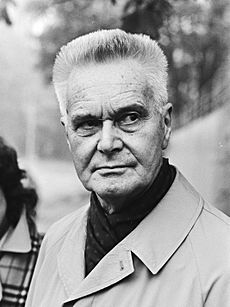Jan Tinbergen facts for kids
Quick facts for kids
Jan Tinbergen
|
|
|---|---|

Jan Tinbergen in 1982
|
|
| Born | 12 April 1903 The Hague, Netherlands
|
| Died | 9 June 1994 (aged 91) The Hague, Netherlands
|
| Nationality | Dutch |
| Alma mater | Leiden University |
| Known for | First national macroeconomic model |
| Awards | Erasmus Prize (1967) Nobel Memorial Prize in Economic Sciences (1969) |
| Scientific career | |
| Fields | Economics, Econometrics |
| Institutions | Erasmus University |
| Doctoral advisor | Paul Ehrenfest |
| Doctoral students | Tjalling Koopmans Hans van den Doel Supachai Panitchpakdi Ashok Mitra |
| Influences | Oskar R. Lange |
Jan Tinbergen (born April 12, 1903 – died June 9, 1994) was a brilliant Dutch economist. He made history in 1969 by becoming one of the first people to win the Nobel Memorial Prize in Economic Sciences. He shared this award with Ragnar Frisch. They were honored for creating and using special models to understand how economies work. Many people see Tinbergen as one of the most important economists of the 20th century. He also helped start a field called econometrics, which uses math and statistics to study economic data.
His important work in econometrics includes creating the first large-scale economic models. He also helped solve the "identification problem" and improved our understanding of how economic systems change over time. Tinbergen was a founding member of "Economists for Peace and Security." In 1945, he started the Bureau for Economic Policy Analysis (CPB) and was its first leader.
Biography
Jan Tinbergen was the oldest of five children. His brother, Nikolaas "Niko" Tinbergen, also won a Nobel Prize in 1973 for his work on animal behavior (ethology). His youngest brother, Luuk, became a famous bird expert. Jan and Nikolaas Tinbergen are the only brothers in history to have both won Nobel Prizes.
From 1921 to 1925, Tinbergen studied mathematics and physics at Leiden University. During this time, he had many important discussions with famous scientists like Paul Ehrenfest and Albert Einstein.
After finishing his studies, Tinbergen worked for a short time in a prison and at the Central Bureau of Statistics (CBS) in The Hague. He then returned to Leiden University and earned his PhD in 1929. His PhD paper was about "Minimisation problems in Physics and Economics." This topic allowed him to combine his love for math, physics, economics, and politics.
The CBS created a new department for business studies and statistics, and Tinbergen became its first head. He worked there until 1945. Having access to all the CBS data helped him test his economic ideas. At the same time, starting in 1931, he taught statistics at the University of Amsterdam. In 1933, he became a professor at The Netherlands School of Economics in Rotterdam, where he taught until 1973.
From 1929 to 1945, he worked for the Dutch statistics office. He also worked briefly as an advisor for the League of Nations from 1936 to 1938. In 1945, he became the first director of the Netherlands Bureau for Economic Policy Analysis. He left this job in 1955 to focus more on teaching. He spent a year as a visiting professor at Harvard University. After that, he returned to the Dutch Economic Institute. He also advised international groups and governments in many developing countries, including Turkey and Indonesia.
Tinbergen became a member of the Royal Netherlands Academy of Arts and Sciences in 1946. In 1956, he started the Econometric Institute at the Erasmus Universiteit Rotterdam. The Tinbergen Institute was later named in his honor. He received many other awards and honors throughout his life, including an honorary doctorate from Concordia University in 1968.
His Important Work
Jan Tinbergen is well-known for something called the "Tinbergen Norm." While he never wrote it down formally, it's generally understood to be the idea that if the difference between the highest and lowest incomes in a society becomes too big (more than 5 times), it can be bad for everyone. Tinbergen believed that a fair distribution of income was very important for a good society.
Tinbergen created the first complete economic model for a whole country. He first developed this model for the Netherlands in 1936. Later, he used it for the United States and the United Kingdom.
In his work on economic models, Tinbergen explained that some economic things are "targets" and others are "instruments."
- Targets are the goals a government or policymaker wants to achieve, like keeping prices stable or creating jobs.
- Instruments are the tools they can use to reach those goals, like changing interest rates or taxes.
Tinbergen said that to reach a certain number of targets, you need to have an equal number of instruments you can control. This idea is known as the Tinbergen Rule.
This rule is still very important today, especially for how central banks manage money. Many central banks aim to control the inflation rate (how fast prices rise). Their main tool (instrument) to do this is the short-term interest rate.
Tinbergen's work on economic models was continued by Lawrence Klein, who also won a Nobel Prize for his contributions. For his cultural work, Tinbergen received the Gouden Ganzenveer award in 1985.
Tinbergen's ideas about economic modeling led to lively discussions with other famous economists like J.M. Keynes and Milton Friedman. These discussions are sometimes called the "Tinbergen debate."
See also
 In Spanish: Jan Tinbergen para niños
In Spanish: Jan Tinbergen para niños
- List of economists


